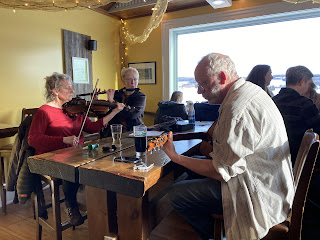This was a very spontaneous trip. Porter Airlines has bought several new jets and is just starting to fly out of Pearson airport. For their inaugural flights with these new jets Porter was offering a limited number of flights for $1 - and even though I still had to pay airport taxes, my return flight to Halifax was only $92.07! I couldn’t pass up that deal!
X marks the spot for the end of the taxiway!
Goodbye Toronto.
And hello to Halifax - in the wee hours of the morning.
I have friends who live in Wolfville - a little town with a population just over 5000, about an hour northwest of Halifax, in the Annapolis Valley. Thankfully they were home and available while I was there, so not only did I get to spend a few days in Halifax, I also had the opportunity to spend a few days with my friends. Although life is rather quiet in Wolfville in the winter, it’s a very pretty place to be. A popular tourist destination because of the views of the Bay of Fundy and the Gaspereau Valley, as well as its wine and cider industry. The downtown street of Wolfville is home to pubs, bars, cafés and shops…so perhaps it’s no surprise that the first photo I took was at one of the local cideries.
Loved this! A few hay bales to help prevent injury when tobogganing.
Acadia University is in Wolfville, and when students are on campus they pretty much double the population of the town. Acadia University was established in 1838 and had a strong Baptist religious affiliation at that time.
University Hall, built in 1925 is a stately white stone building over-looking the university lawns. It is regarded by many to be the University’s landmark.
Seminary House, is a Second Empire style-building constructed in 1878 as a home for women attending the university. It was designated a National Historic Site of Canada in 1997 as Canada’s oldest facility associated with the higher education of women.
Although fairly recently built, the K.C. Irving Environmental Science Centre is a beautiful building with spaces that fit in beautifully with Acadia’s history. This room is known as the Garden Room and is a lovely, bright, airy room for meeting, studying, and also for musical concerts!
Manning Memorial Chapel, at Acadia, was opened and dedicated in 1963. The church spire, with a six-foot cross covered with gold leaf, towers 198 feet above sea level.
A 20-stop classical Casavant organ.
And just off campus - a beautiful purple house!
The Cornwallis River, with its mouth on the Minas Basin, is a tidal river near Wolfville. Here it is at low(er) tide…
…and again a few hours later, now full of water.
Wellington Dyke is an agricultural dyke protecting over 3,000 acres of farmland. Built by local farmers, it was begun in 1817 and completed in 1825. Originally, the rich farmlands along the river were dyked by the Acadians to claim highly productive farmland from the Bay of Fundy tidal meadows of the Minas Basin. Beginning in the late 1600s, Acadians built progressively larger dykes as well as a sluice with a one-way valve, which allowed the river to drain but shut out the incoming tide.
Climbing - well driving really - up towards Blomidon to look down on the countryside and the Minas Basin.
Space Paddy Bog People playing at one of the local craft breweries. So fun!
The Minas Basin - looking towards Blomidon
Right at Wolfville are the Wickwire Dyke and the Bishop-Beckwith Dyke, the tops of which are both great walking trails.
Work at the Trestle by Ruth Abernethy features a figure portrait of T.T. Vernon Smith, civil engineer and builder of the Windsor and Annapolis Railway which operated from 1869 to 1894.
The Joy is Almost Too Much to Bear by Nistal Prem de Boer features Nova Scotia war hero Mona Parsons who saved the lives of Allied airmen in occupied Holland until she was betrayed and imprisoned in 1941. When she escaped four years later, ill and starving, she walked 200 kilometres to safety. The sculpture captures her moment of liberation.
The Tide Flowers by Michael and Daniel Burt was commissioned to mark Wolfville’s 125th anniversary of incorporation. Painted on the side of the Herbin Jewellers building, the mural captures words from the poetry of John Frederic Herbin (1860-1923) who established the business in 1885 (and it is still operating today).















































No comments:
Post a Comment